An Optimized Detection Approach to Subsurface Coalfield Spontaneous Combustion Areas Using Airborne Magnetic Data
Abstract
1. Introduction
2. Methodology and Tests
2.1. Constrained Inversion Based on Coal Seam Information
2.2. The Artificial Model Tests
3. Background and Data
3.1. The Background of the Coalfield Spontaneous Combustion Area
3.2. The Geophysical Characteristics of the Coalfield Spontaneous Combustion Area
3.3. The Topographic Data
3.4. The Coal Seam Altitude Data
3.5. The Temperature Data of Airborne Infrared Remote Sensing Measurement
3.6. The Airborne Magnetic Data
4. Results
5. Discussion
- (1)
- “Block a” has the largest areas of high-temperature anomalies, and there is smoke on the surface, so it is the most serious area of spontaneous combustion. However, most of the high-temperature anomalies are located in the inferred coalfield spontaneous combustion areas, indicating that these high-temperature anomalies correspond to the old spontaneous combustion areas. Therefore, it is speculated that the coals around these high-temperature anomalies are basically burned out, and the temperature will gradually decrease. In contrast, the spontaneous combustion areas in the middle of “Block a” will spread to the northeast, southeast, and northwest sides, as shown in Figure 12, while those at the northwest corner will spread northwest, as shown in Figure 12.
- (2)
- “Block b” is connected to “Block a” and “Block e”, and the high-temperature anomalies are mostly within the inferred coalfield spontaneous combustion areas. The coal seam near these high-temperature anomalies is also inferred to lead to a subsequent temperature decrease. As shown in Figure 12, it is inferred that the spontaneous combustion areas at the eastern corner of “Block b” will spread eastward, while those at the western corner will spread northwestward and connect with “Block c” in the future.
- (3)
- “Block c” is connected to “Block e”, and from the high-temperature anomalies outside the inferred coalfield spontaneous combustion areas at the northeast and southeast sides of “Block c”, it is inferred that the coalfield spontaneous combustion areas will spread in the direction shown in Figure 12 in the future and will be connected with “Block b”.
- (4)
- “Block d” is not connected to other blocks at present, and the high-temperature anomalies are mostly within the inferred coalfield spontaneous combustion areas. The coal seam near these high-temperature anomalies is also inferred to undergo a subsequent temperature decrease. On the northwest side of “Block d”, there are some high-temperature anomalies outside the inferred coalfield spontaneous combustion areas. Therefore, it is deduced that these inferred coalfield spontaneous combustion areas will spread northwestward, as shown in Figure 12, and gradually connect with “Block g”.
- (5)
- “Block e” is connected to “Block b” and “Block c”, and there are no high-temperature anomalies in the inferred coalfield spontaneous combustion areas, and it is inferred that the coalfield spontaneous combustion areas in this block are older than those in other blocks. At present, the coal seam is in a state in which the temperature has decreased after spontaneous combustion. On the southwest side of “Block e”, there are some high-temperature anomalies outside the inferred coalfield spontaneous combustion areas. Therefore, it is inferred that coalfield spontaneous combustion areas will spread southwestward, as shown in Figure 12.
- (6)
- “Block f” is connected to “Block a” and “Block b”, and the high-temperature anomalies are located at the east of inferred coalfield spontaneous combustion areas. Therefore, it is deduced that these inferred coalfield spontaneous combustion areas will spread eastward, as shown in Figure 12, and ignite the coal to the east side of the survey area.
- (7)
- “Block g” is not connected to other blocks at present, and it has the smallest inferred coalfield spontaneous combustion areas. Therefore, it is deduced that these inferred coalfield spontaneous combustion areas are newer than those in other blocks. The spread state of these inferred coalfield spontaneous combustion areas is not stable. Based on the current data, it is speculated that the inferred coalfield spontaneous combustion areas will spread westward in the future, but this inference has great instability.
- (8)
- “Block h” is not connected to other blocks at present, and the high-temperature anomalies are located at the southeast of inferred coalfield spontaneous combustion areas. Therefore, it is deduced that these inferred coalfield spontaneous combustion areas will spread southeastward, as shown in Figure 12.
- (9)
- “Block i” is similar to “Block g”, and the inferred coalfield spontaneous combustion areas are small. Based on the current data, it is speculated that the inferred coalfield spontaneous combustion areas will spread westward and southwestward, but this inference has great instability.
6. Conclusions
Author Contributions
Funding
Data Availability Statement
Conflicts of Interest
References
- Glenn, B.; Tammy, P. Coal fires burning out of control around the world: Thermodynamic recipe for environmental catastrophe. Int. J. Coal Geol. 2004, 59, 7–17. [Google Scholar] [CrossRef]
- Cao, Q.; Yan, S.; Xue, G.; Zhu, N. High resolution resistivity detecting and remote internet monitoring of coalfield fire. Chin. J. Geophys. 2017, 60, 424–429. (In Chinese) [Google Scholar] [CrossRef]
- Zheng, Y.; Li, Q.; Zhu, P.; Li, X.; Zhang, G.; Ma, X.; Zhao, Y. Study on Multi-field Evolution and Influencing Factors of Coal Spontaneous Combustion in Goaf. Combust. Sci. Technol. 2021, 195, 247–264. [Google Scholar] [CrossRef]
- Ma, Z.; Qin, B.; Shi, Q.; Zhu, T.; Chen, X.; Liu, H. The location analysis and efficient control of hidden coal spontaneous combustion disaster in coal mine goaf: A case study. Process Saf. Environ. Prot. 2024, 184, 66–78. [Google Scholar] [CrossRef]
- Chen, J.; Li, L.; Jiang, D.; Zhou, L.; Wang, L. Experimental study on the spatial and temporal variations of temperature and indicator gases during coal spontaneous combustion. Energy Explor. Exploit. 2021, 39, 354–366. [Google Scholar] [CrossRef]
- Gao, S.; Gao, D.; Liu, Y.; Chai, J.; Chen, J. Distribution Law of Coal Spontaneous Combustion Hazard Area in Composite Goaf of Shallow Buried Close Distance Coal Seam Group. Combust. Sci. Technol. 2021, 195, 1960–1980. [Google Scholar] [CrossRef]
- Shi, X. Research and application of comprehensive electromagnetic detection technique in spontaneous combustion area of coalfields. Saf. Sci. 2012, 50, 655–659. [Google Scholar] [CrossRef]
- Anghelescu, L.; Diaconu, B.M. Advances in Detection and Monitoring of Coal Spontaneous Combustion: Techniques, Challenges, and Future Directions. Fire 2024, 7, 354. [Google Scholar] [CrossRef]
- Shao, Z.; Wang, D.; Wang, Y.; Zhong, X. Theory and application of magnetic and self-potential methods in the detection of the Heshituoluogai coal fire, China. J. Appl. Geophys. 2014, 104, 64–74. [Google Scholar] [CrossRef]
- Zhang, B.; Xiao, F.; Jin, W. Burnt coal field detection via magnetic exploration. Environ. Earth Sci. 2023, 82, 160. [Google Scholar] [CrossRef]
- Ma, G.; Ma, S.; Li, L.; Cai, J. Method of self-structure-constrained inversion of magnetic anomalies and their magnetic gradients and its application in the exploration of coal burning area. Prog. Geophys. 2024, 39, 1026–1037. (In Chinese) [Google Scholar] [CrossRef]
- Ide, T.S.; Crook, N.; Orr, F.M., Jr. Magnetometer measurements to characterize a subsurface coal fire. Int. J. Coal Geol. 2011, 87, 190–196. [Google Scholar] [CrossRef]
- Liang, S.; Sun, S.; Lu, H. Application of Airborne Electromagnetics and Magnetics for Mineral Exploration in the Baishiquan–Hongliujing Area, Northwest China. Remote Sens. 2021, 13, 903. [Google Scholar] [CrossRef]
- Accomando, F.; Bonfante, A.; Buonanno, M.; Natale, J.; Vitale, S.; Florio, G. The drone-borne magnetic survey as the optimal strategy for high-resolution investigations in presence of extremely rough terrains: The case study of the Taverna San Felice quarry dike. J. Appl. Geophys. 2023, 217, 105186. [Google Scholar]
- Ma, G.; Meng, L.; Li, L. Fast Magnetization Vector Inversion Method with Undulating Observation Surface in Spherical Coordinate for Revealing Lunar Weak Magnetic Anomaly Feature. Remote Sens. 2024, 16, 432. [Google Scholar] [CrossRef]
- Shi, X.; Geng, H.; Liu, S. Magnetization Vector Inversion Based on Amplitude and Gradient Constraints. Remote Sens. 2022, 14, 5497. [Google Scholar] [CrossRef]
- Ma, G.; Zhao, Y.; Xu, B.; Li, L.; Wang, T. High-Precision Joint Magnetization Vector Inversion Method of Airborne Magnetic and Gradient Data with Structure and Data Double Constraints. Remote Sens. 2022, 14, 2508. [Google Scholar] [CrossRef]
- Kim, B.; Jeong, S.; Bang, E.; Shin, S.; Cho, S. Investigation of Iron Ore Mineral Distribution Using Aero-Magnetic Exploration Techniques: Case Study at Pocheon, Korea. Minerals 2021, 11, 665. [Google Scholar] [CrossRef]
- Liu, S.; Tan, H.; Peng, M.; Li, Y. Three-Dimensional Limited-Memory BFGS Inversion of Magnetic Data Based on a Multiplicative Objective Function. Appl. Sci. 2023, 13, 11198. [Google Scholar] [CrossRef]
- Meng, Q.; Ma, G.; Li, L.; Wang, T.; Li, Z.; Wang, N. Joint Inversion of Gravity and Magnetic Data with Tetrahedral Unstructured Grid and its Application to Mineral Exploration. IEEE Trans. Geosci. Remote Sens. 2023, 61, 5915514. [Google Scholar] [CrossRef]
- Abbas, M.A.; Speranza, L.; Fedi, M.; Garcea, B.; Bianco, L. Magnetic data modelling of salt domes in Eastern Mediterranean, offshore Egypt. Acta Geophys. 2024, 72, 1293–1303. [Google Scholar]
- Wang, C.; Hu, P.; Sun, Y.; Yang, C. Study on CO source identification and spontaneous combustion warning concentration in the return corner of working face in shallow buried coal seam. Environ. Sci. Pollut. Res. 2024, 31, 15050–15064. [Google Scholar] [CrossRef]
- Zhou, L.; Zhang, D.; Wang, J.; Huang, Z.; Pan, D. Mapping Land Subsidence Related to Underground Coal Fires in the Wuda Coalfield (Northern China) Using a Small Stack of ALOS PALSAR Differential Interferograms. Remote Sens. 2013, 5, 1152–1176. [Google Scholar] [CrossRef]
- Stoll, J.; Moritz, D. Unmanned aircraft systems for rapid near surface geophysical measurements. In Proceedings of the 75th EAGE Conference & Exhibition-Workshops, London, UK, 10–13 June 2013. [Google Scholar]
- Accomando, F.; Vitale, A.; Bonfante, A.; Buonanno, M.; Florio, G. Performance of two different flight configurations for drone-borne magnetic data. Sensors 2021, 21, 5736. [Google Scholar] [CrossRef]
- Dual Mag System. Available online: http://www.mgt-geo.com/dual%20mag%20system.htm (accessed on 22 July 2021).
- Mu, Y.; Zhang, X.; Xie, W.; Zheng, Y. Automatic detection of near-surface targets for unmanned aerial vehicle (UAV) magnetic survey. Remote Sens. 2020, 12, 452. [Google Scholar] [CrossRef]
- Parvar, K.; Braun, A.; Layton-Matthews, D.; Burns, M. UAV magnetometry for chromite exploration in the Samail ophiolite sequence, Oman. J. Unmanned Veh. Syst. 2017, 6, 57–69. [Google Scholar]
- Malehmir, A.; Dynesius, L.; Paulusson, K.; Paulusson, A.; Johansson, H.; Bastani, M.; Wedmark, M.; Marsden, P. The potential of rotary-wing UAV-based magnetic surveys for mineral exploration: A case study from central Sweden. Lead. Edge 2017, 36, 552–557. [Google Scholar]
- Cunningham, M.; Samson, C.; Wood, A.; Cook, I. Aeromagnetic surveying with a rotary-wing unmanned aircraft system: A case study from a zinc deposit in Nash Creek, New Brunswick, Canada. Pure Appl. Geophys. 2018, 175, 3145–3158. [Google Scholar]
- Walter, C.; Braun, A.; Fotopoulos, G. High-resolution unmanned aerial vehicle aeromagnetic surveys for mineral exploration targets. Geophys. Prospect. 2020, 68, 334–349. [Google Scholar]
- Schmidt, V.; Becken, M.; Schmalzl, J. A UAV-borne magnetic survey for archaeological prospection of a Celtic burial site. First Break 2020, 38, 61–66. [Google Scholar]
- Accomando, F.; Florio, G. Drone-Borne Magnetic Gradiometry in Archaeological Applications. Sensors 2024, 24, 4270. [Google Scholar] [CrossRef] [PubMed]
- Yu, B.; She, J.; Liu, G.; Ma, D.; Zhang, R.; Zhou, Z.; Zhang, B. Coal fire identification and state assessment by integrating multitemporal thermal infrared and InSAR remote sensing data: A case study of Midong District, Urumqi, China. ISPRS J. Photogramm. Remote Sens. 2022, 190, 144–164. [Google Scholar] [CrossRef]
- Pandey, J.; Kumar, D.; Mishra, R.K.; Mohalik, N.K.; Khalkhoand, A.V.K. Application of Thermography Technique for Assessment and Monitoring of Coal Mine Fire: A Special Reference to Jharia Coal Field, Jharkhand, India. Singh Int. J. Adv. Remote Sens. GIS 2013, 2, 138–147. [Google Scholar]
- Wang, H.; Fang, X.; Li, Y.; Zheng, Z.; Shen, J. Research and application of the underground fire detection technology based on multi-dimensional data fusion. Tunn. Undergr. Space Technol. 2021, 109, 103753. [Google Scholar] [CrossRef]
- Wang, H.; Fan, C.; Chen, L.; Chen, X.; Zhang, J.; Zhong, H. Research on early identification of burning status in a fire area in Xinjiang based on data-driven. Case Stud. Therm. Eng. 2024, 60, 104685. [Google Scholar] [CrossRef]
- Chiu, L.S.-Y.; Lai, W.W.-L.; Santos-Assunção, S.; Sandhu, S.S.; Sham, J.F.-C.; Chan, N.F.-S.; Wong, J.C.-F.; Leung, W.-K. A Feasibility Study of Thermal Infrared Imaging for Monitoring Natural Terrain—A Case Study in Hong Kong. Remote Sens. 2023, 15, 5787. [Google Scholar] [CrossRef]
- Frodella, W.; Elashvili, M.; Spizzichino, D.; Gigli, G.; Adikashvili, L.; Vacheishvili, N.; Kirkitadze, G.; Nadaraia, A.; Margottini, C.; Casagli, N. Combining InfraRed Thermography and UAV Digital Photogrammetry for the Protection and Conservation of Rupestrian Cultural Heritage Sites in Georgia: A Methodological Application. Remote Sens. 2020, 12, 892. [Google Scholar] [CrossRef]
- Li, Y.; Oldenburg, D. 3-D inversion of magnetic data. Geophysics 1996, 61, 394–408. [Google Scholar]
- Meng, Q.; Ma, G.; Li, L.; Wang, T.; Li, Z.; Li, J. The ES-GNF Method of Unstructured Tetrahedral Mesh for Fast Inversion of Gravity and Magnetic Data with Undulating Terrain. IEEE Trans. Geosci. Remote Sens. 2024, 62, 5934215. [Google Scholar] [CrossRef]
- Ghalehnoee, M.H.; Ansari, A. Compact magnetization vector inversion. Geophys. J. Int. 2021, 228, 1–16. [Google Scholar]
- Meng, Q.; Ma, G.; Li, L.; Wang, T.; Han, J. 3-D cross-gradient joint inversion method for gravity and magnetic data with unstructured grids based on second-order taylor formula: Its application to the southern Greater Khingan range. IEEE Transac. Geosci. Remote Sens. 2022, 60, 5914816. [Google Scholar]
- Bianco, L.; Tavakoli, M.; Vitale, A.; Fedi, M. Multiorder sequential joint inversion of gravity data with inhomogeneous depth weighting: From near surface to basin modeling applications. IEEE Trans. Geosci. Remote Sens. 2023, 62, 4700311. [Google Scholar]
- Vitale, A.; Fedi, M. Self-constrained inversion of potential fields through a 3D depth weighting. Geophysics 2020, 85, G143–G156. [Google Scholar]
- Hansen, P.C. Analysis of discrete ill-posed problems by means of the L-curve. SIAM Rev. 1992, 34, 561–580. [Google Scholar]
- Shewchuk, J.R. Delaunay refinement algorithms for triangular mesh generation. Comput. Geom. 2002, 22, 21–74. [Google Scholar] [CrossRef]
- Walter, C.; Braun, A.; Fotopoulos, G. Characterizing electromagnetic interference signals for unmanned aerial vehicle geophysical surveys. Geophysics 2021, 86, J21–J32. [Google Scholar] [CrossRef]
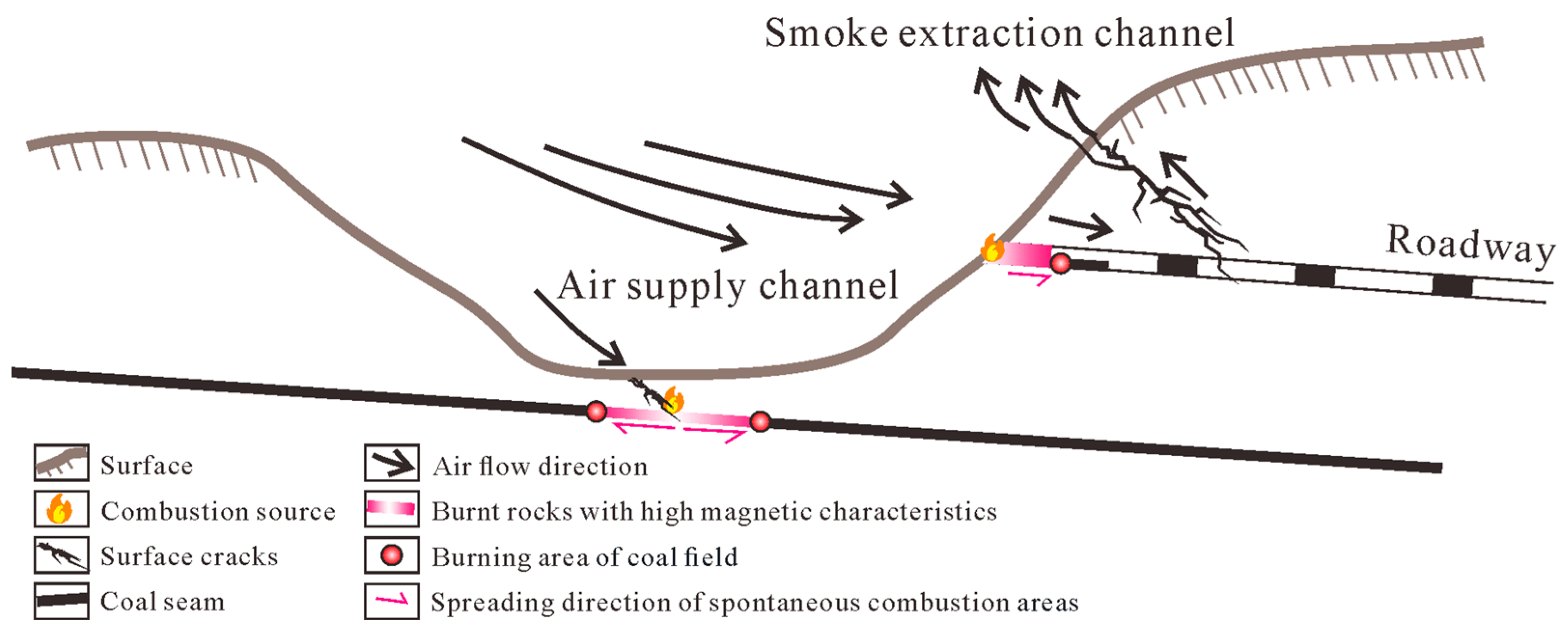
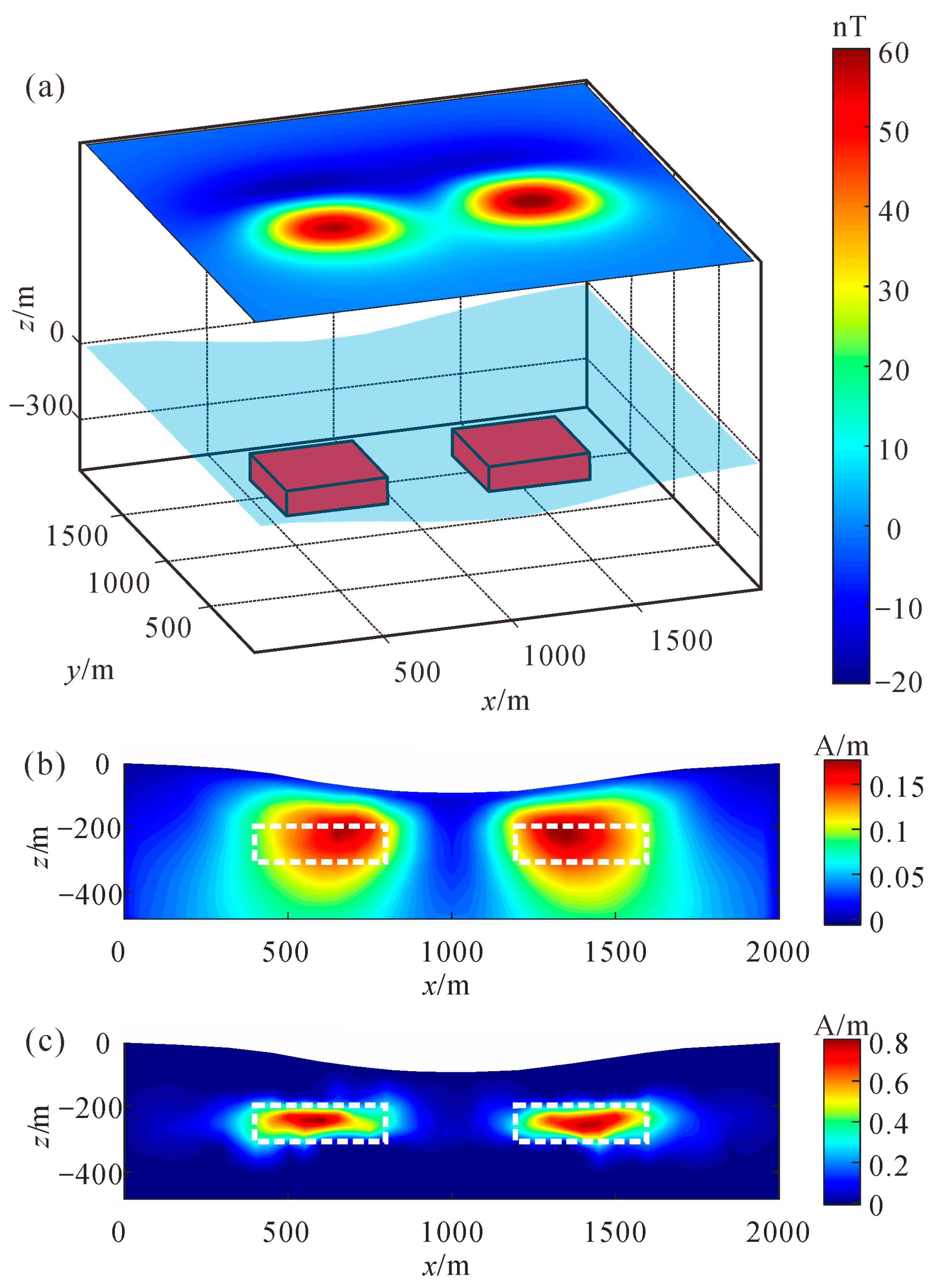


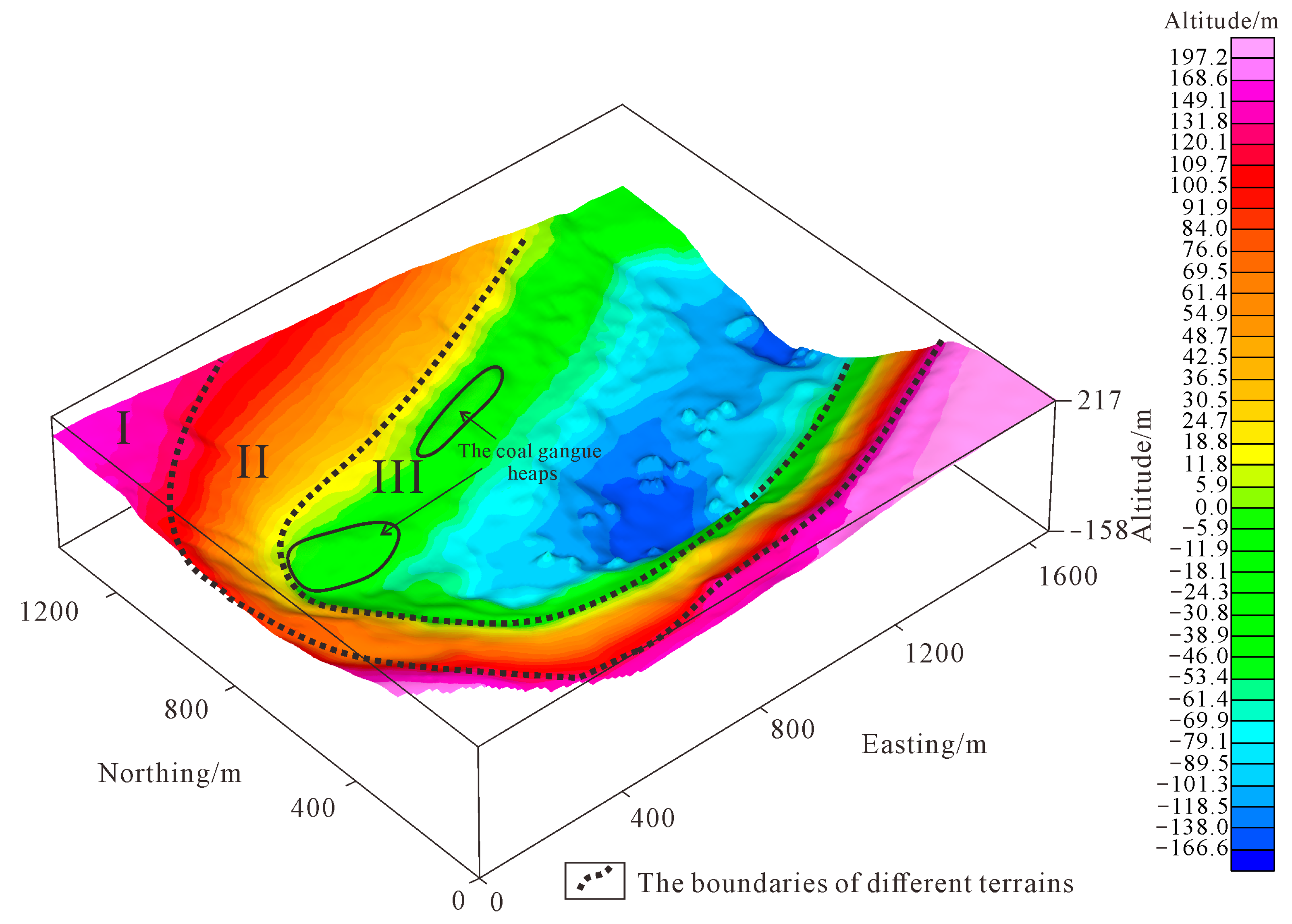
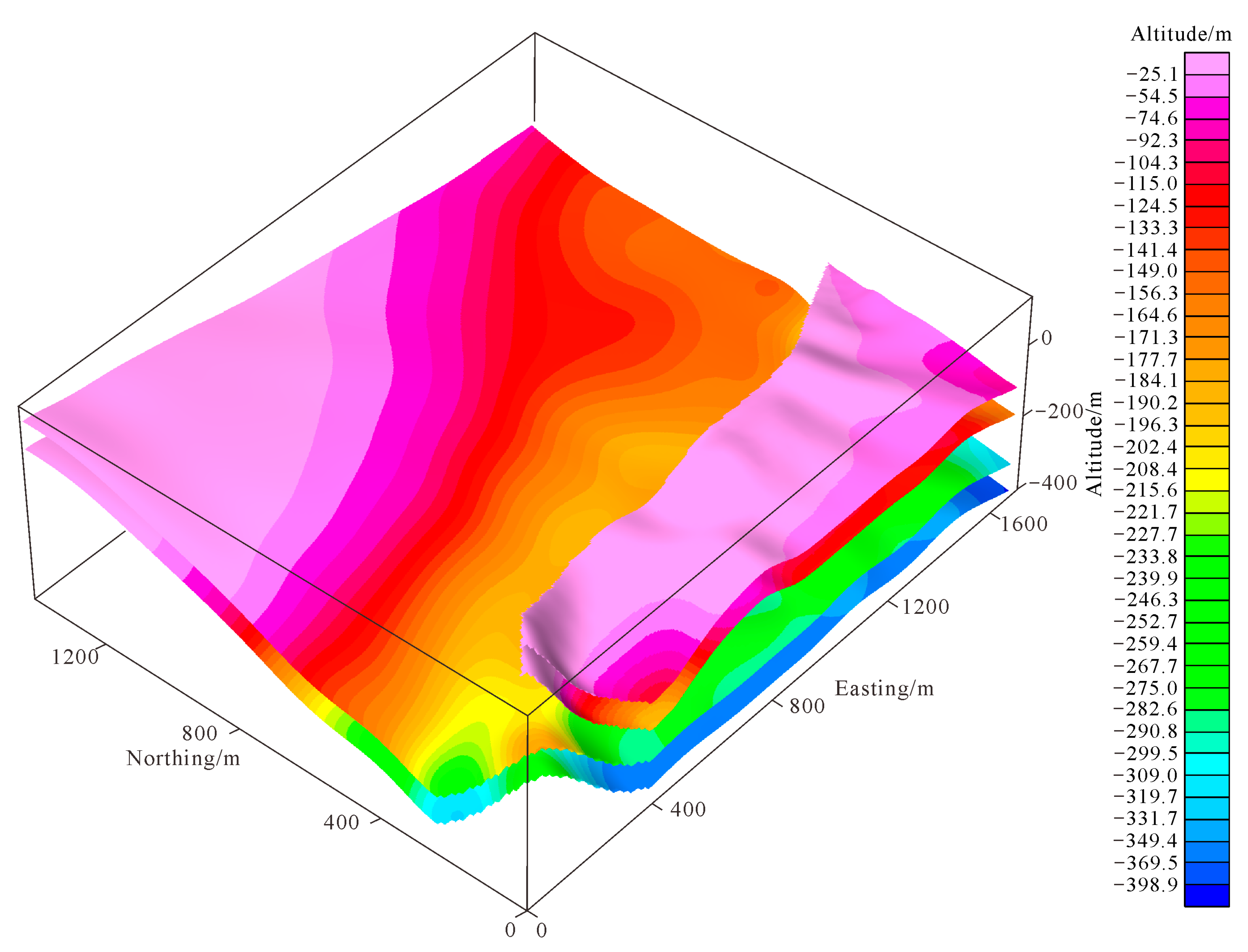

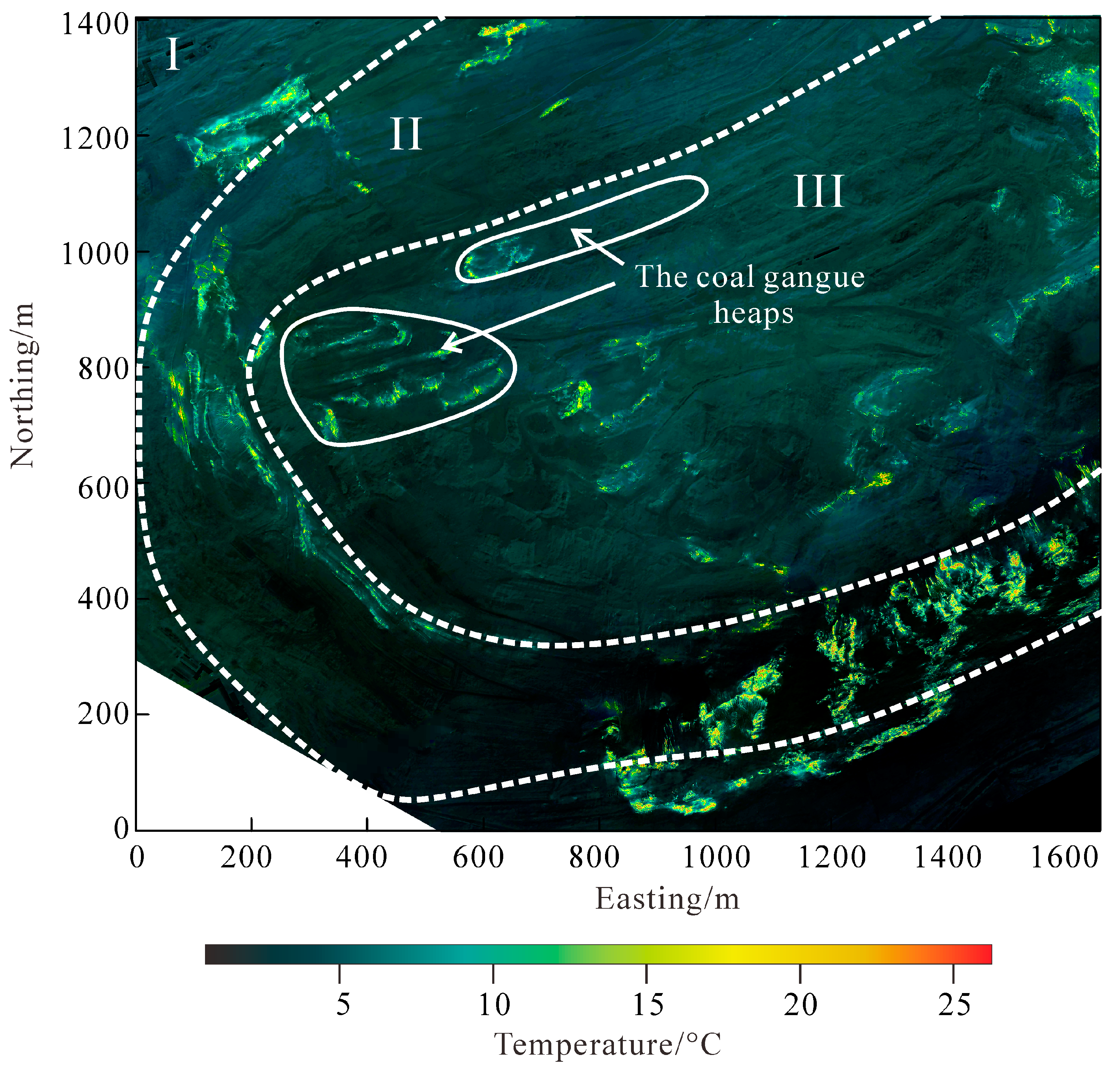


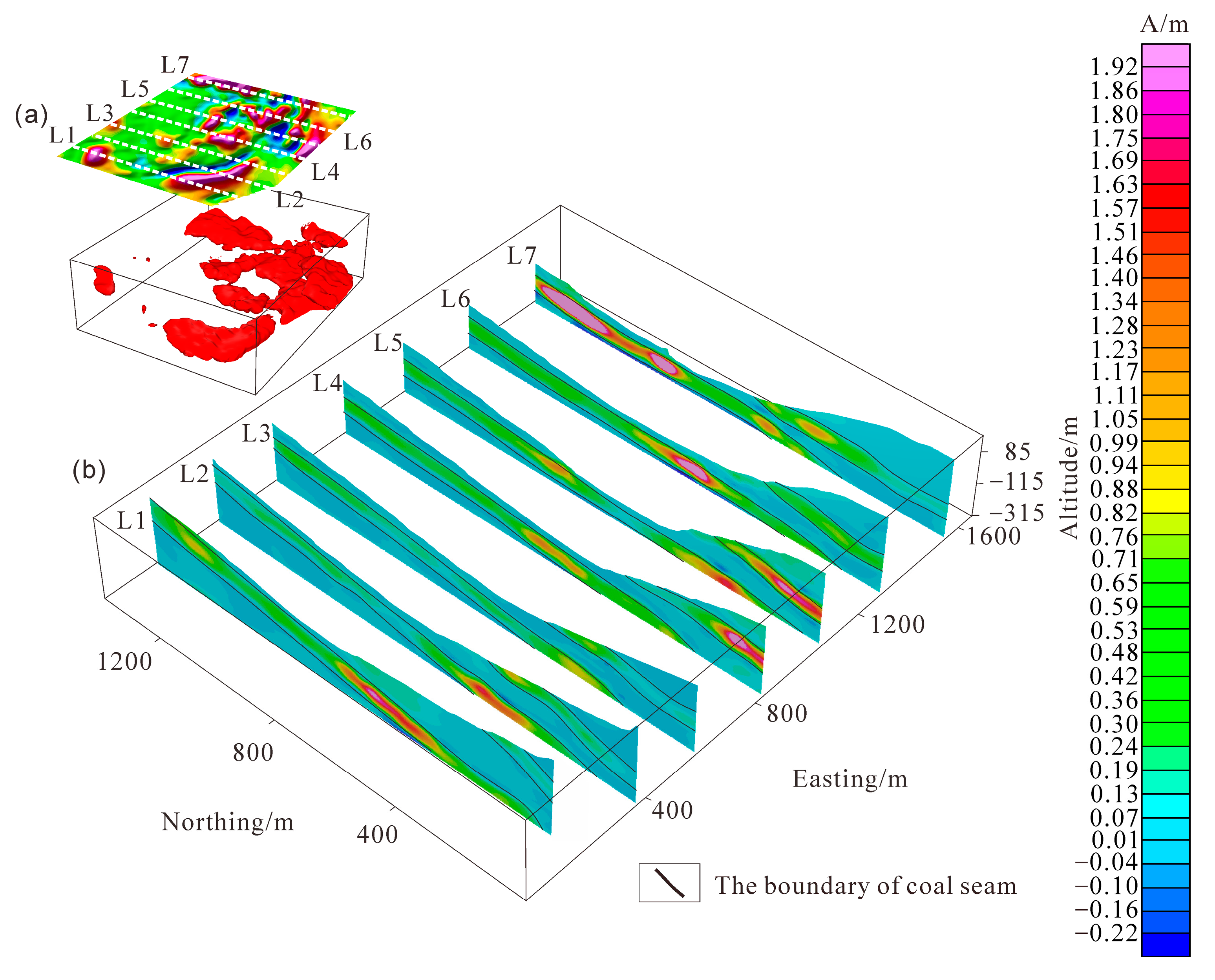
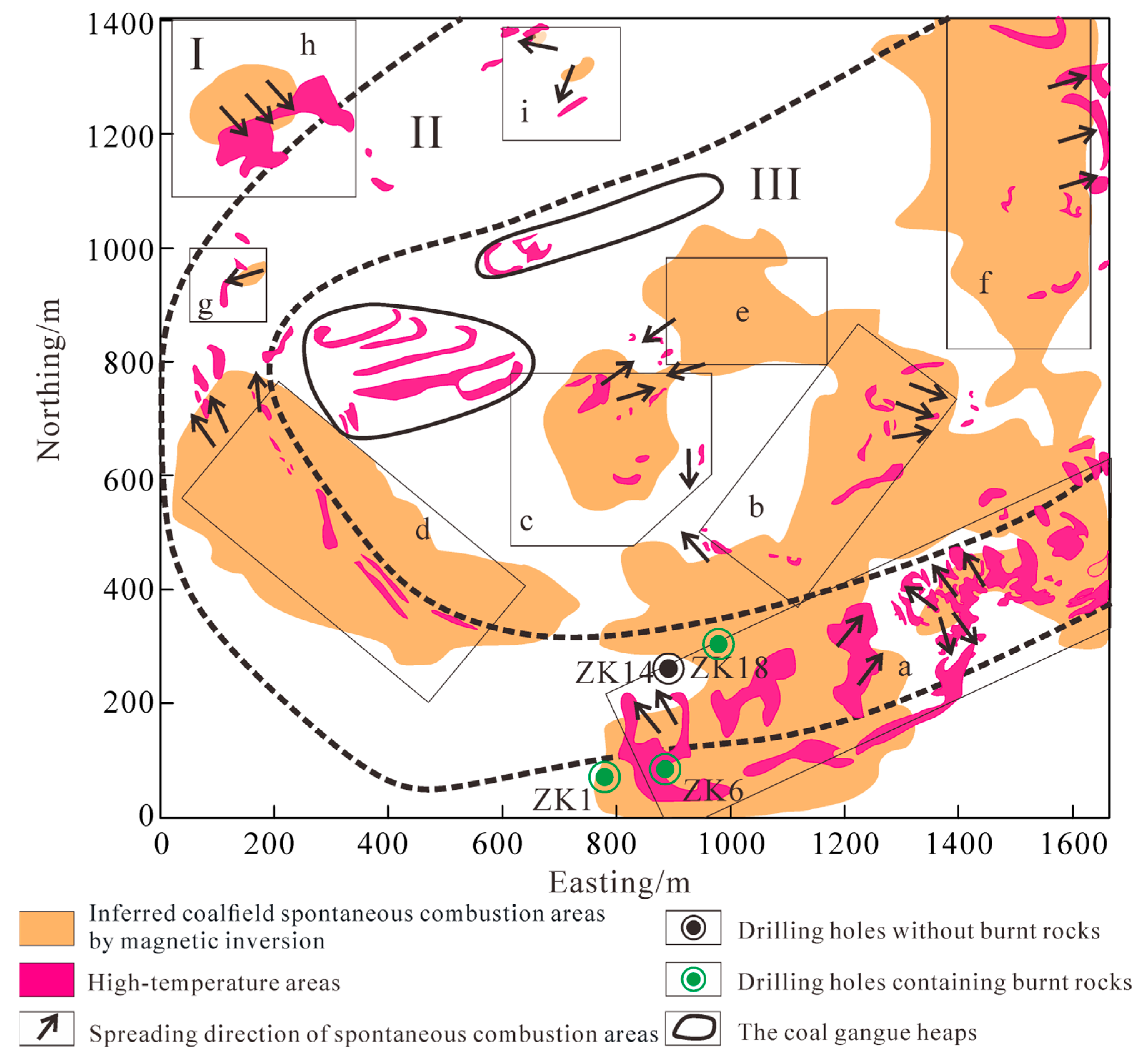
| The Rock Sample Type | The Average Magnetic Susceptibility (SI) | |
|---|---|---|
| 1 | Mudstone | 0.42 × 10−3 |
| 2 | Sandstone | 0.41 × 10−3 |
| 3 | Conglomerate | 0.13 × 10−3 |
| 4 | Coal | 0.02 × 10−3 |
| 5 | Burnt rock | 2.71 × 10−3 |
| Areas | The Center Altitude of Coalfield Spontaneous Combustion Areas (m) |
|---|---|
| Block a | −79.57 |
| Block b | −246.92 |
| Block c | −224.23 |
| Block d | −241.25 |
| Block e | −201.54 |
| Block f | −187.36 |
| Block g | −107.93 |
| Block h | 36.73 |
| Block i | −99.43 |
Disclaimer/Publisher’s Note: The statements, opinions and data contained in all publications are solely those of the individual author(s) and contributor(s) and not of MDPI and/or the editor(s). MDPI and/or the editor(s) disclaim responsibility for any injury to people or property resulting from any ideas, methods, instructions or products referred to in the content. |
© 2025 by the authors. Licensee MDPI, Basel, Switzerland. This article is an open access article distributed under the terms and conditions of the Creative Commons Attribution (CC BY) license (https://creativecommons.org/licenses/by/4.0/).
Share and Cite
Meng, Q.; Ma, G.; Li, L.; Li, J. An Optimized Detection Approach to Subsurface Coalfield Spontaneous Combustion Areas Using Airborne Magnetic Data. Remote Sens. 2025, 17, 1185. https://doi.org/10.3390/rs17071185
Meng Q, Ma G, Li L, Li J. An Optimized Detection Approach to Subsurface Coalfield Spontaneous Combustion Areas Using Airborne Magnetic Data. Remote Sensing. 2025; 17(7):1185. https://doi.org/10.3390/rs17071185
Chicago/Turabian StyleMeng, Qingfa, Guoqing Ma, Lili Li, and Jingyu Li. 2025. "An Optimized Detection Approach to Subsurface Coalfield Spontaneous Combustion Areas Using Airborne Magnetic Data" Remote Sensing 17, no. 7: 1185. https://doi.org/10.3390/rs17071185
APA StyleMeng, Q., Ma, G., Li, L., & Li, J. (2025). An Optimized Detection Approach to Subsurface Coalfield Spontaneous Combustion Areas Using Airborne Magnetic Data. Remote Sensing, 17(7), 1185. https://doi.org/10.3390/rs17071185







